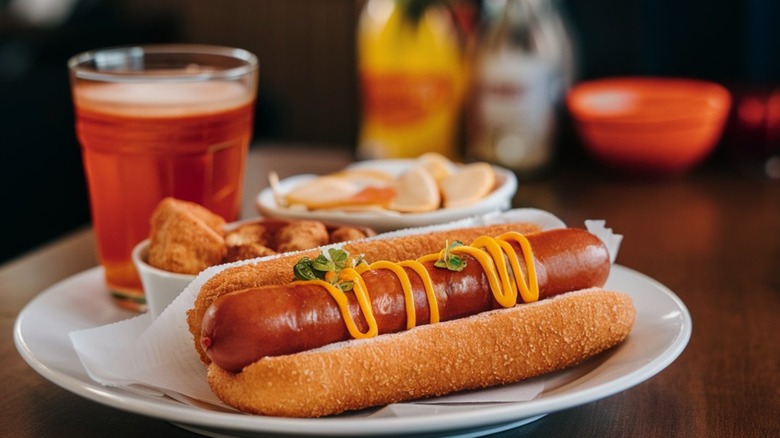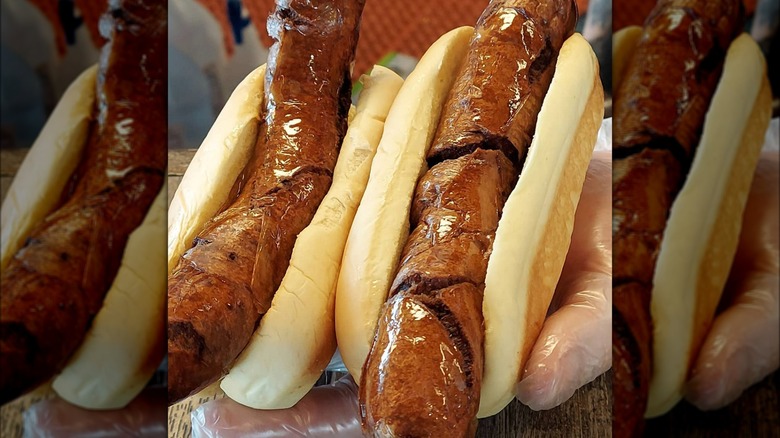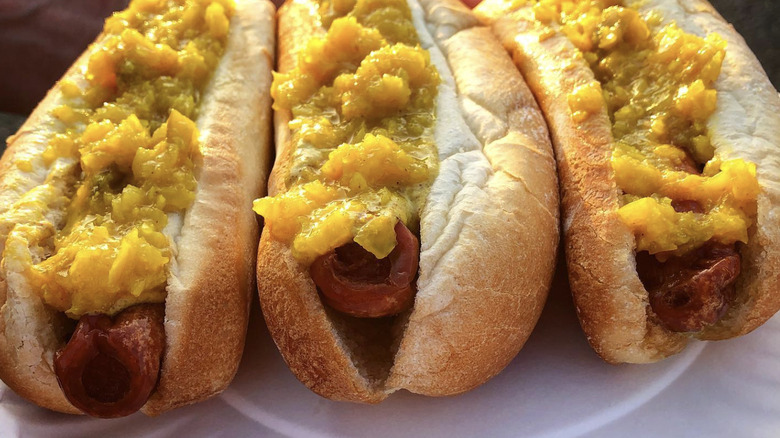Yes, You Can (And Should) Deep-Fry Hot Dogs
There are a whole lot of fun ways to cook a hot dog and plenty of hacks you need to try to ensure a perfect frank-in-bun. Store-bought hot dogs may have questionable ingredients, but they're nevertheless a top-rated enduring protein source and fun food for people of all ages and demographics. Hot dogs are particularly and historically popular in the United States, especially in the summertime. Picnics, barbecues, and other outdoor celebrations are the perfect outlet to cook up a batch of wieners, pair with some buns, top with a mess of condiments, and enjoy.
Hot dogs have endured as a go-to favorite for so long, perhaps because they're so versatile. They can be cooked with virtually any kitchen appliance or via any outdoor method. But while a broiler, microwave, or grill can consistently guarantee a winning wiener, another way has only recently gained in popularity outside the region of its creation. Bust out that deep-fryer and set it up on the counter or the patio because cooking your hot dogs using the deep-frying method is worthwhile and rewarding.
Deep-fried hot dogs originated in New Jersey
The deep- or oil-fried hot dog is also known as a New Jersey-style hot dog. The method was pioneered and popularized by Rutt's Hut, which started as a simple stand in 1928. Rutt's Hut takes credit for inventing fried hot dogs called "Rippers." During the intensely hot cooking process in hot oil, tears or rips open up in the frankfurters' casings, giving them a distinctive shriveled and cracked appearance.
Those rips and cracks are also visual proof of what fans of the deep-fried hot dog say is one of the dish's pleasurable aspects — they give a hearty, pronounced snap when bitten. The outside of the hot dog stays crispy, like what one would get if those wieners were charred on a grill, but without that bitter aftertaste. The inside of the deep-fried hot dog remains tender, juicy, and cooked to the correct level of doneness.
How to make the perfect deep-fried hot dogs
All that's required to make deep-fried hot dogs is some oil and something to hold and heat that oil. The hot dogs aren't breaded in any way, as that would make it something like a corn dog. Hot dogs, bare and raw, are left to cook in vegetable or peanut oil. Authentic deep-fried hot dogs are made with wieners that have natural casings, which shrink immediately upon hitting the oil and provide a pleasing snap in the finished product. How the hot dog gets fried is up to the home cook — a basket-based deep fryer can be used, as can a pan or Dutch oven on a stovetop, provided it can be filled up with oil to a depth where it can almost entirely cover the dogs. They're ready to go once the temperature reaches the ideal hot dog frying temperature of 350 degrees Fahrenheit.
If cooked in an immersive oil bath in a deep fryer, the dogs will cook on all sides; if prepared with the pan or Dutch oven method, they'll need to be turned occasionally to prevent burning. Regardless, the wieners are ready to be removed from the hot oil when they develop that blistered and split appearance. They're also at their best when left on paper towels to allow excess oil to be soaked off, then served up hot, on a bun, and with one's preferred hot dog toppings — because a deep-fried hot dog is still a hot dog.


